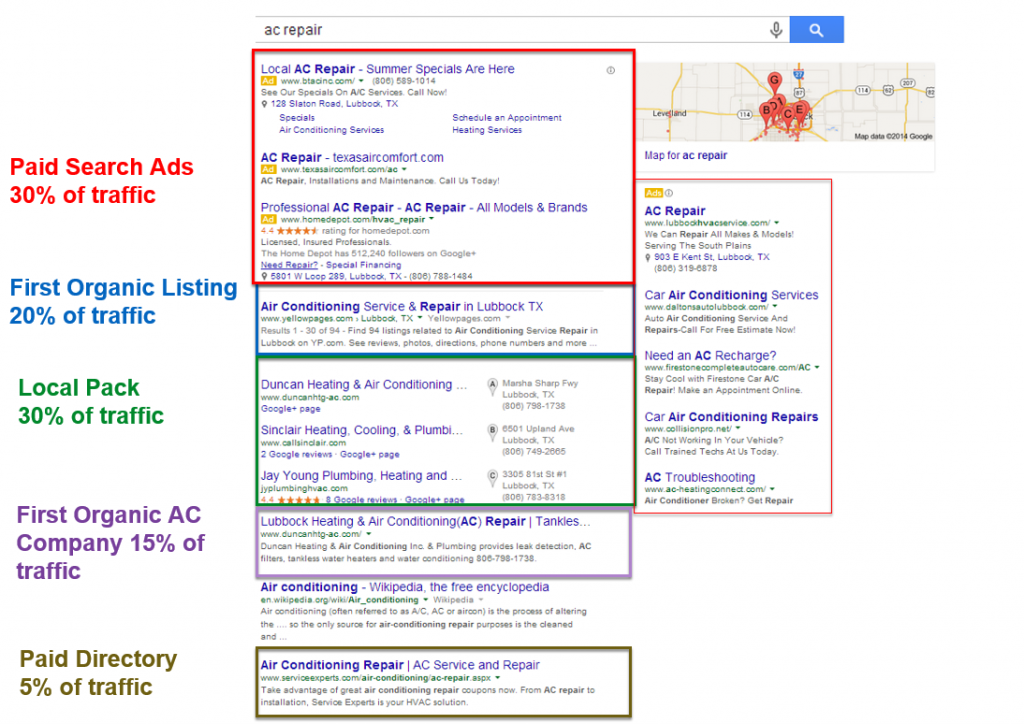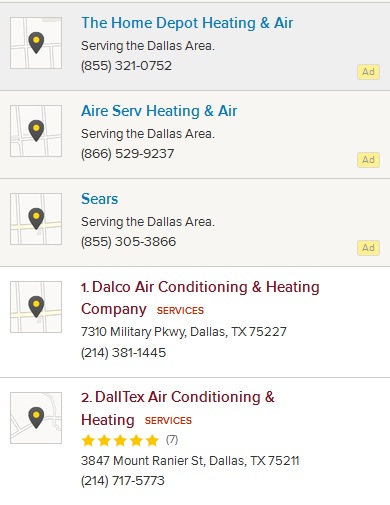How Did Advertising on Yellow Pages Work?
Before the internet, advertising was simple. There were only a handful of channels to reach customers: radio, TV, billboards, print, direct mail and the yellow pages. The internet changed the number of ways to advertise and consumer behavior (how consumers research, interact and buy from businesses.
The Path of a Customer on Yellow Pages (Before Internet)
- Open the book (which everyone owned)
- Look at the section for the service you need
- Choose the first company listed (a reason why many companies have AAA in their name)
- Or choose a company you are familiar with (advertising impressions from other channels or word of mouth)
- Or choose a company based on size of the ad, design or content
Many business owners gravitated towards yellow pages, viewing it as a one size fits all solution for advertising. For many, advertising on TV, print journals/magazines, radio, etc. weren’t needed. Yellow pages were in everyone’s house and were the means for reaching the masses. Paid on a yearly contract, you could also ‘set it and forget it’. Yellow Pages allowed a business owner to effectively outsource all marketing and advertising.
Enter the Search Engine Era
Search engines are hands down, the greatest internet invention of our time. It’s the number one online destination of all online users and it’s how customers now find the answer to anything.
But does everyone use search? Yes, for the most part; only demographics who have limited access to the internet use search the least.
Some statistics pulled from this interesting infographic on search users
- The poor are less likely to have access to the internet, and search the least of all income groups (but it’s still 84%)
- The uneducated use search the least of any demographic (at 78%)
- 80% of seniors (65+) use search engines, the least of any age group
Great, now that we established a majority of the population uses search engines, which one? As of August 2014, Google had 67% of the market on PC’s and on mobile it’s 87%. Bing and Yahoo (Yahoo uses Bing to power search results) are near 30%.
Is Google the New Yellow Pages?
To say Google or search engines simply replaced Yellow Pages is a misnomer, it went above and beyond what Yellow Pages offered.
- Search changed the way consumers find information online, enabling anyone with an internet connected device to find the answer to any question/problem
- Yellow Pages offered a narrow and controlled look at a brand and its product/service. Search is more transparent and in depth
- Businesses held their position in Yellow Pages for a year. Their Ad never went away or was lower on the page. In Search, organic visibility and even paid ads can change position constantly
- Search shifted the power to the customer. The customer now has the power to review your business product/service. The customer can influence others on social media and the customer can promote or negatively hurt your brand online.
- Consumers now evaluate a product/service on hundreds of factors (visibility, reputation such as reviews/trust factors, familiarity, brand and many more)
Because search engines changed the way consumers interact with brands online, the customer journey is much more complex, and advertising as a result is much more complex. Think of all the ways a potential customer might find and choose to buy services from an HVAC company using the internet:
First a company needs to be visible, second it needs to stand out from competition.

1. A potential customer may type in a popular keyword phrase like “ac repair” into Google
- They may simply convert on the first result (a paid advertisement in Google) because they need a solution quickly
- They may click on the first organic result, because the company included that they won a local award for the Best HVAC Company
- They may click on the online Yellow Pages, wanting to view a list of local companies
- They may click on the business with the most positive reviews in the local map pack of Google, valuing reputation over other factors
- They might click on the Better Business Bureau, because they want to view companies with the fewest complaints
- They may choose a company, because it the site actually loads on their mobile device and they can make a decision on the go.
- They may click on a site that independently evaluates all HVAC businesses in their market based on customer satisfaction
2. A potential customer may have a Trane air conditioner that needs repaired. And go to the Trane website to find a qualified dealer
3. A potential customer may ask their friends on social media, or popular Q&A sites (quora/yahoo answers) for who the best HVAC contractor is in their market
4. A potential customer may type in a longer phrase like “Trane air conditioner coolant is leaking”
- They end up on a local HVAC contractor’s website, who maintains a blog and explains how to fix the issue.
5. A potential customer might go directly to Angie’s List, seeking companies with positive reviews
6. A potential customer may remember getting a coupon via an email from the HVAC contractor that originally installed their system. They go back and use the coupon with the same company
For this HVAC business, many forms of paid marketing and organic marketing can occur before ultimately convincing a prospect to convert. How many were there?
Paid Marketing:
- You can pay to be more visible on Yellow Pages
- You can pay to be more visible on Angie’s List
- You can pay to be more visible on BBB (Better Business Bureau)
- You can pay for advertising in Google (Google Adwords)
Organic Marketing:
- Earning reviews or putting a process in place to ask customers for reviews
- The business name, address and phone appearing in the local “map pack” in Google
- The homepage ranking towards the top in Google
- Earning an award, getting nominations for important local/industry awards
- Being listed on Trane’s website as a certified dealer
- Being independently evaluated among competitors on a review site
- Blogging often, attempting to answer common questions
- Answering questions on popular Q&A sites related to your business
- Being visible and engaging with potential customers in social media
- Sending regularly targeted emails to old customers, leads, current customers
- Creating a mobile website, to reach the growing number of consumers using smartphones
Takeaway 1: Yellow Pages is only one of Many Ways to Reach Customers
Yellow Pages is not the only option, there are hundreds of other ways to reach a customer in their journey to find the best product/service online. Many strategies are more valuable than paying for Yellow Pages. The Yellow Page website may rank well online for several of your business keywords. Paying Yellow Pages can get you more visible on the YP.com website. But Yellow Pages is no longer the destination, that would be Google.
Takeaway 2: Paid Advertising is Different from Organic Marketing
Google became the most popular search engine, because of it’s separation between advertising and organic results. Businesses can still pay to be visible in Google  Adwords, but it can only be the top three listings and side ads. Paying for Google advertising does not influence a website’s ability to rank in non-paid results. Many consumers, estimated at 70% – 80% ignore paid advertising and instead click on organic results which could be an HVAC contractor, it could be Yellow Pages, it could be a Trane website.
Adwords, but it can only be the top three listings and side ads. Paying for Google advertising does not influence a website’s ability to rank in non-paid results. Many consumers, estimated at 70% – 80% ignore paid advertising and instead click on organic results which could be an HVAC contractor, it could be Yellow Pages, it could be a Trane website.
The image on the right shows typical online YP.com results. For many larger markets, YP doesn’t limit the number of online ads, so you could be one in 20 other advertisers (how effective do you think that really would be?). Google on the other hand limits it to three results in standard listings.
Many consumers will also scroll past the ads, ignoring your listing and choosing businesses ranked in YP organically (which is free). First positions are based on location to the city center, reviews and having in depth listings.
Takeaway 3: The Value of Organic Marketing
Organic marketing is what many search engine optimization consultants perform. It involves visibility in all areas digital and attempts to drive traffic to websites through all potential customer touch points.
Organic marketing is less black and white as paid advertising. Getting an equal return on all costs can be difficult to estimate as it involves much more time and ownership of business owners and agencies. It is best executed with a combination of an internal team and outside consultants/agencies.
How Should Business Owners Change?
Many business owners are still in the mindset Yellow Pages helped create.
- Business owners can no longer expect to outsource all marketing. They must be involved at some level + either hire internal employees to manage or agencies/consultants.
- Marketing is 24/7, it is no longer a once a year exercise. The customer can research your business any day of the week, at any hour and you may not be visible and you may not stand out.
- Business owners cannot place all their eggs in one basket. Advertising only on Google is not even the answer. Evaluate different forms of marketing and constantly measure. Understand the impact of your advertising budget and what you are getting in return. Be leery of anyone who says their platform is the solution.

